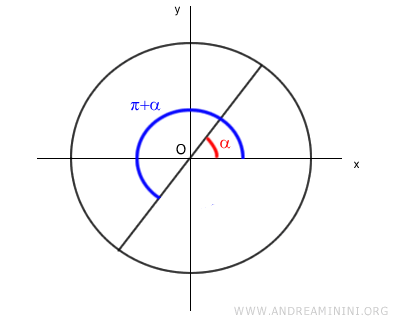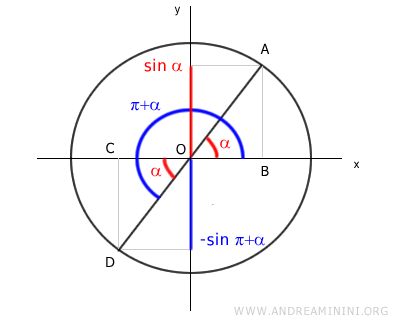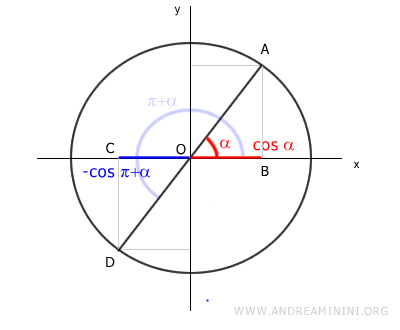Associated Angles α and π+α
In trigonometry, the angles alpha (α) and π+α allow us to apply the following transformation formulas: $$ \sin(\pi+\alpha) = -\sin(\alpha) $$ $$ \cos(\pi+\alpha) = -\cos(\alpha) $$ $$ \tan(\pi+\alpha) = \tan(\alpha) $$ $$ \cot(\pi+\alpha) = \cot(\alpha) $$
As associated angles, α and π+α have the same absolute values for the trigonometric functions (sine, cosine, tangent, and cotangent).
Proof and Explanation
Let's consider an angle α and its associated angle π+α on a unit circle.

The difference between α and π+α is a straight angle of 180° (π).
$$ (\pi + \alpha) - \alpha = \pi $$
Now, let's construct two right triangles, OAB and OCD.

The right triangles OAB and OCD are congruent (identical) since they share the same hypotenuse (OA = OC) and have the same acute angle (α) as well as a right angle (90°).
Because of this, the two triangles have equal angles and side lengths.
Therefore, α and π+α have the same absolute value for the sine function, as the heights of the triangles are equal, AB = CD.
$$ \sin \alpha = | \sin (\pi + \alpha) | $$
Visually speaking:

However, AB is on the positive y-axis, while CD is on the negative y-axis.
Thus, the sine of the associated angles α and π+α have opposite signs.
$$ \sin \alpha = - \sin (\pi + \alpha) $$
Note: By multiplying both sides of the equation by -1, we can also express the relationship in reverse: $$ (-1) \cdot \sin \alpha = (-1) \cdot (- \sin (\pi + \alpha)) $$ $$ - \sin \alpha = \sin (\pi + \alpha) $$
Similarly, α and π+α have the same absolute value for the cosine function, as OB = OD.

Here again, the cosine values are opposite, since OC lies on the negative x-axis and OB on the positive x-axis.
$$ \cos \alpha = - \cos (\pi + \alpha) $$
Note: By multiplying both sides of the equation by -1, we can also express this in reverse: $$ (-1) \cdot \cos \alpha = (-1) \cdot ( - \cos (\pi + \alpha) ) $$ $$ - \cos \alpha = \cos (\pi + \alpha) $$
Thus, the cosine of the associated angles α and π+α have opposite signs.
At this point, we can derive the transformation formulas for tangent and cotangent.
The tangent is defined as the ratio between sine and cosine.
$$ \tan (\pi + \alpha) = \frac{ \sin (\pi + \alpha) }{ \cos (\pi + \alpha) } $$
Knowing that sin(π+α) = -sin(α) and cos(π+α) = -cos(α), we have:
$$ \tan (\pi + \alpha) = \frac{ - \sin \alpha }{ - \cos \alpha } = \tan \alpha $$
So, the tangent of π+α is equal to the tangent of α.
The cotangent is defined as the ratio between cosine and sine.
$$ \cot (\pi + \alpha) = \frac{ \cos (\pi + \alpha) }{ \sin (\pi + \alpha) } $$
Since sin(π+α) = -sin(α) and cos(π+α) = -cos(α), we get:
$$ \cot (\pi + \alpha) = \frac{ - \cos \alpha }{ - \sin \alpha } = \cot \alpha $$
Therefore, the cotangent of π+α is equal to the cotangent of α.
In conclusion, the associated angles α and π+α have the same values for tangent and cotangent.
A Practical Example
Let's calculate the sine of 210°:
$$ \sin 210° $$
We can rewrite 210° as the sum of 180° + 30°:
$$ \sin 210° = \sin (180° + 30°) $$
In radians, this becomes:
$$ \sin 210° = \sin \left( \pi + \frac{\pi}{6} \right) $$
The angles π+α and α are associated, where α = π/6 (or 30°).
$$ \sin (\pi + \alpha) = -\sin(\alpha) $$
Thus, the sine of 210° is the negative of the sine of 30°:
$$ \sin 210° = \sin \left( \pi + \frac{\pi}{6} \right) = -\sin \left( \frac{\pi}{6} \right) $$
Since the sine of 30° is 1/2, the sine of 210° is -1/2.
$$ \sin 210° = - \frac{1}{2} $$
And so on.
